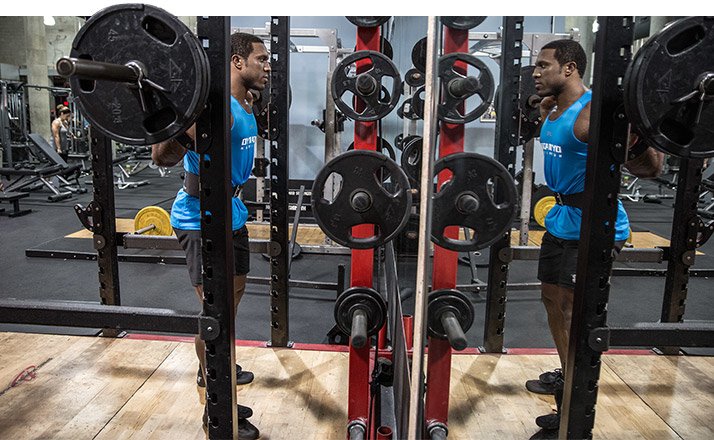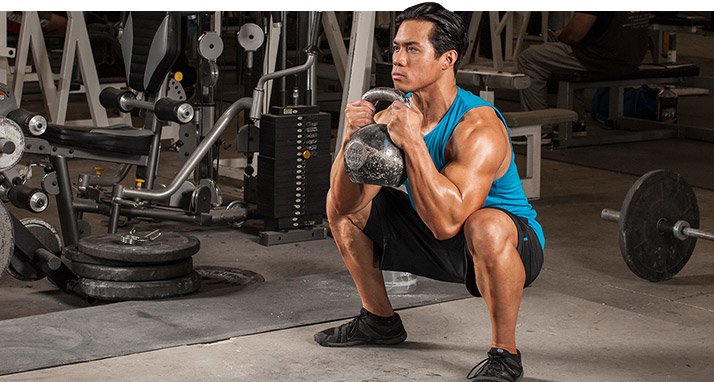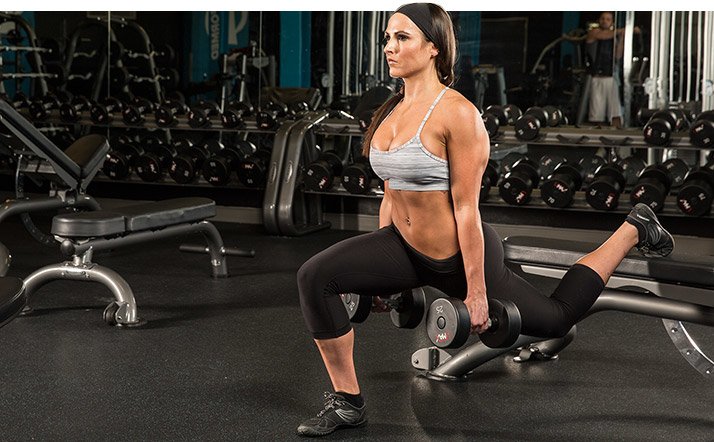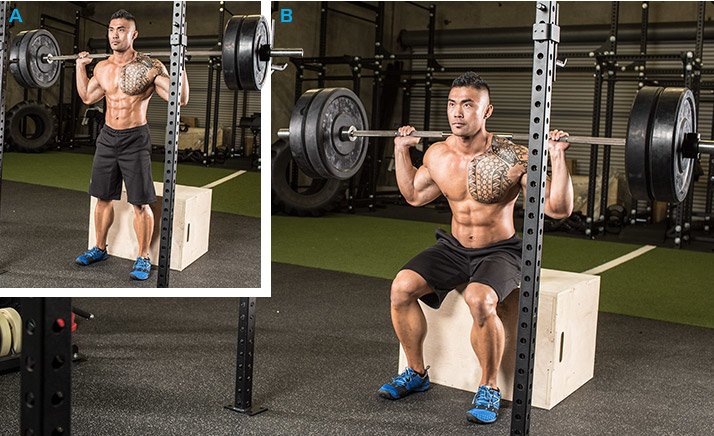
3 Squats Variations Better Than Your Bad Back Squat
Too often, people try to pretend they can back squat. Unfortunately, their backs, knees, and shoulders end up bearing the brunt of the work. Here's what they should be doing instead!
No exercise helps you to quickly accumulate mass and strength like the barbell back squat. It's heads and shoulders above just about every other bodybuilding exercise, and it's rightly heralded as the king of strength moves. Pretty special, right?
But everything I just wrote comes with a big caveat: "as long as you do it right." And by "right," I mean deep, strong, with rock-solid form, and—this part is crucial—without pain.
So let me put this out there: If you can't back squat correctly and without pain, you shouldn't do it—not yet, anyway. It's an unfortunate reality, but despite what some people will shout at you over the Internet, it's not a condemnation to a life devoid of leg size and strength.
You have options, and they're all superior to doing crap-ass squats that feel wrong and look even worse. Let's explore a few alternatives.
When Squatting Isn't an Option
The back squat is a full-body lift. The upside to this is that it's perhaps the greatest bang-for-your-buck movement you can do. The downside is that all manner of anatomical problems can get in the way of your ability to do it.
Hip, back, and shoulder injuries, as well as mobility limitations, are among the most common issues limiting squatting ability. Lack of hip and ankle mobility is also a notorious culprit that keeps ladies and gents from loading a bar across their shoulders. If you feel your ankles pulling up and knees caving in as you approach parallel, I'm talking to you.

You may know exactly what old (or new) injury is holding back your squat. Experienced lifters generally have a bag of tricks to help open their creaky shoulders, mobilize their sticky hips, wake up their stubborn ankles, and do a bunch of other mysterious-sounding body voodoo. In many cases, the more experienced you are, the more your workout routine gets consumed by warming up.
Squatting for other folks induces more general pain. Those with mobility limitations can't bodyweight squat to parallel without their backs rounding or their hips tucking under, a phenomenon known as "butt wink." This can lead to pervasive back soreness at best, and acute injury at worst.
Long story short, if you're not ready to squat, then trying to pretend you are is going to be a battle. Many trainees say that the move just doesn't feel right, and the more cues they try to follow, the more painful shoehorning their body into "proper form" becomes. In that instance, I recommend sticking with this timeless advice: If it hurts, don't do it.
If you experience any of these conditions, barbell squatting is a bad choice. Working on the restrictions that are holding you back is a good idea, but so is continually refining your squatting movement with these back squat alternatives.
If you're limited by a back or shoulder issue, you may well not be able to do back squats safely. But the goblet squat can save the day.
This increasingly popular move is hard to do wrong technique-wise, but just as crucially, it's not as big a step down in terms of overall difficulty as you think. Pooh-pooh it if you will, but goblet squats with a 70-pound kettlebell or 100-pound dumbbell are no joke. Try them, and you will be surprised by how heavy they feel, and how much deeper and better you're squatting than usual.

Goblet Squat
To perform a goblet squat, grab a dumbbell or kettlebell and hold it snug to your chest, just under your chin. Now squat, making sure to send your hips backward, knees outward as you descend. Goblet squatting moves the load from the back of the body to the front, activating more of the anterior core muscles and reducing back stress. The counterbalance of the weight also keeps you more upright, resulting in a deeper, safer squat. Shoulder stress is also reduced because your shoulders are maintained in a safe, neutral position.
Can you do them wrong? Of course. You can still bend over too much or let your knees cave with goblet squats. But guard against those two flaws, and you're pretty much in the clear otherwise.
This bad boy is incredible. It works for low-rep and high-rep sets, from sets of 5 to sets of 30. If you plan low-rep, heavy goblet-squat sets, be sure to have a partner help you position the weight.
Adequate hip and ankle mobility are critical to back squatting correctly. Split squats, however, demand far less hip and ankle mobility, meaning you can still work the quads, hamstrings, and glutes without the problems caused by limited mobility. Many people treat these as an accessory move to back squats or front squats, but if you hit them hard, they can definitely function as the main course.
Set up in the half-kneeling position, with one knee on the ground bent to 90 degrees, and the other leg in front, foot flat on the floor, with the knee also bent to 90 degrees. This position aligns the legs for solid split-squat reps. Now lift the back knee off the ground and hold this position. Perform reps by extending the legs fully in place and then returning to the bottom position, stopping just short of the back knee touching the floor.

Bulgarian Split Squat
If you'd like more of a challenge, elevate your back foot on a bench or box 12-18 inches high. This elevated squat is called a Bulgarian split squat, and if you're not accustomed to the extra range of motion they provide, you might feel 24 hours later like the "split" in their name describes what happened deep in your glutes and hamstrings.
Perform sets of 5-10 reps per side, and be sure to maintain 90-degree angles at the knees. To load split squats, hold a dumbbell or kettlebell in each hand, or hold a single dumbbell or kettlebell in the goblet position.
Have a back and set of shoulders in full working order, but lack hip and ankle mobility to squat deeply and well? The high box squat is your strength-building squat solution.
Find a box or bench that aligns your hips and legs a few inches above parallel when you squat onto it. Perform the coveted, strength-building box squat by setting your feet a bit wider than you do for regular squats and reaching back to the box until your shins are perpendicular with the floor. Ascend by pushing your knees out and driving into the bar.

Box Squat
Two keys to box squatting are to squeeze your upper back hard and maintain a rigid, neutral spine. This is, of course, true of all squats. But since box squats ask the lifter to reach the hips farther back than normal, tension and spine neutrality gain greater importance.
Since high box squats are big strength builders, I like to program them for sets of no more than 3-8 reps.
Adjust Tempo When You Can't Increase Weight
Obviously, you can't use the same loads with moves like goblet squats and split squats that you can with barbell back squats. Sure, both varieties feel heavier than you expect, but as your strength catches up to the initial challenge, you need to get creative to increase their difficulty to build muscle and strength.
One simple way is to slow down the tempo. Perform 3- to 6-second eccentrics, or negatives, with slower concentrics to keep tension on the muscle for a longer period of time. This process increases the exercise's stress and improves muscular growth.
Here's an example: Perform a goblet squat with a five-second eccentric, a two-second pause at the bottom, and a two-second concentric. That's nine seconds of time under tension for a single rep! Preform 5-8 reps, and you've accumulated a lot of muscle-building stress.
Look, I know that loading up that leg press until it looks like a tank feels like an accomplishment—probably more so than struggling to squat under the weight of a single dumbbell or kettlebell. But in my book, becoming proficient in any of the varieties I've described here will do more to make you a strong, capable lifter for years to come than even the heaviest leg press ever could.
Pick your squat and master it—it's that simple!
